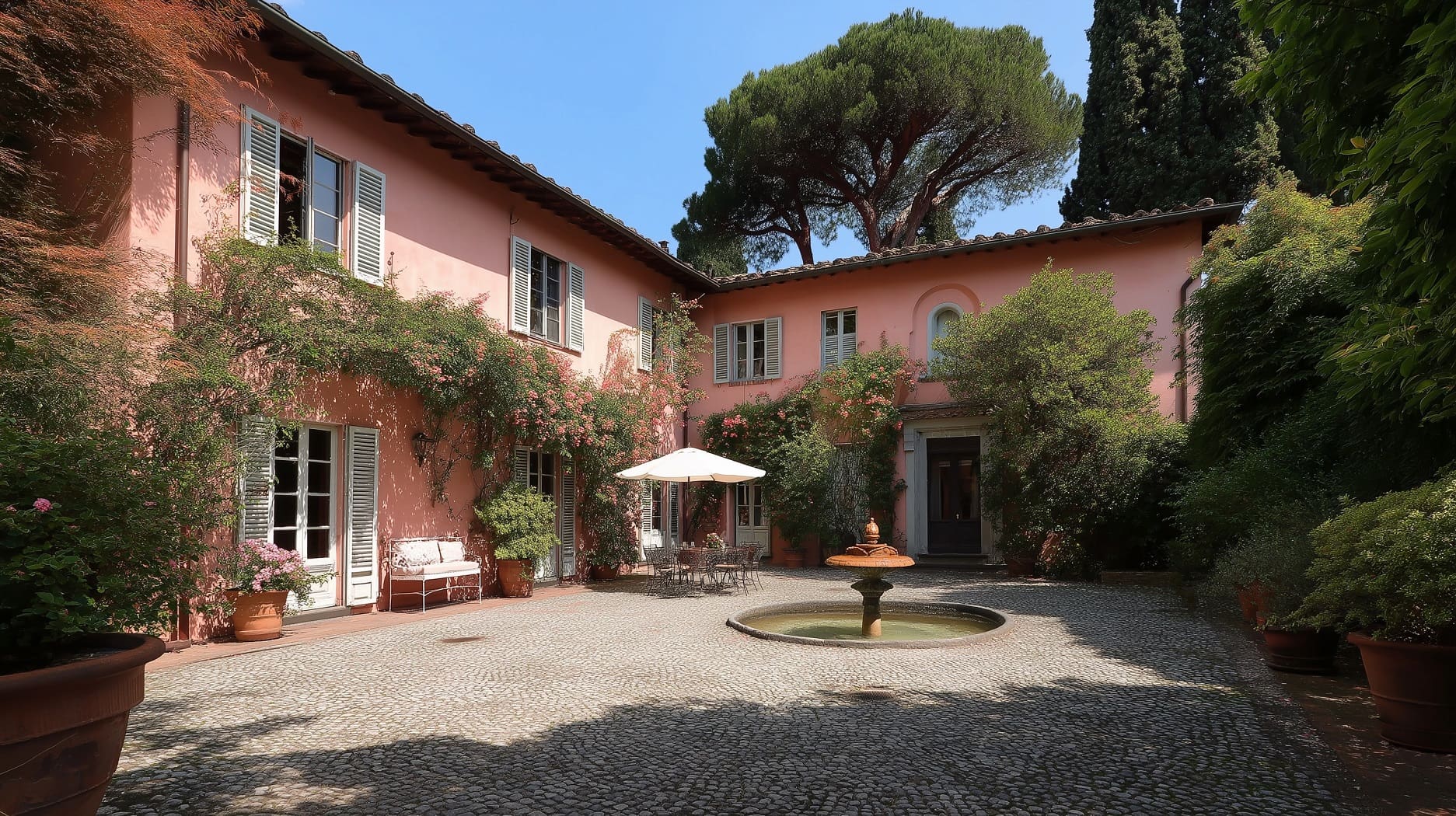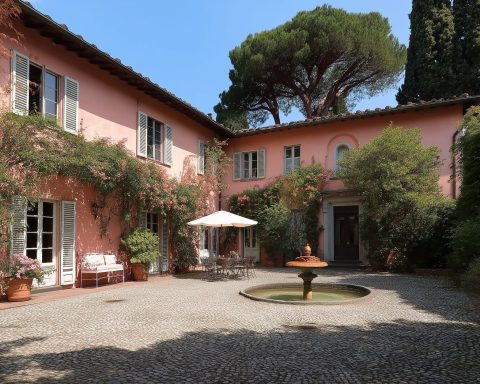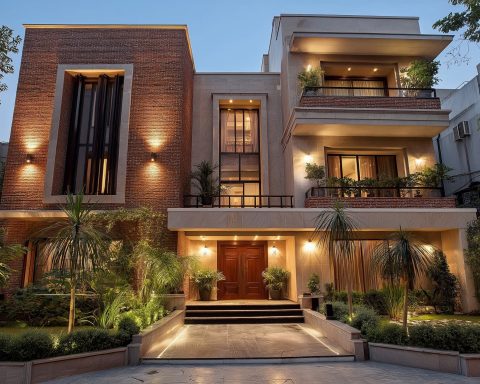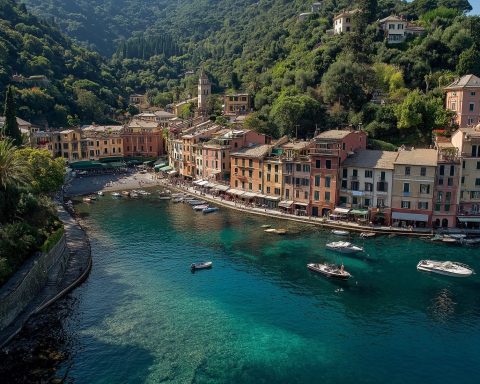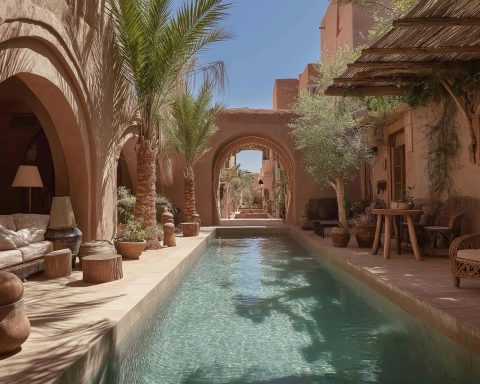Overview of Lucca’s Real Estate Landscape
Lucca, a historic walled city in Tuscany, has a dynamic real estate market that has shown resilience and growth through the mid-2020s. After a brief cooling in 2022-2023 due to rising interest rates, the market rebounded in 2024 and early 2025 with rising prices and strong demand luccaindiretta.it lanazione.it. Lucca stands out as one of Tuscany’s top-performing property markets: property values have climbed steadily, especially in the luxury segment, driven by the city’s relative affordability compared to Florence and the growing interest of international buyers worldpropertyjournal.com. According to Knight Frank’s Prime International Residential Index, Lucca’s prime residential prices rose +6.2% in 2024, among the highest in Italy idealista.it. Over the past five years, Lucca’s luxury home prices have surged about 27%, outpacing other Tuscan hotspots worldpropertyjournal.com and reflecting robust demand. The broader Italian context is supportive – despite modest GDP growth, Italy in 2024 saw subdued inflation and a strong labor market, creating stability for real estate investments cushmanwakefield.com.
Today, Lucca’s property market benefits from a unique mix of factors. The city’s rich cultural heritage and quality of life make it a desirable “lifestyle” location in Tuscany, not just for locals but for buyers from across Europe and the U.S. worldpropertyjournal.com. Lucca province includes exclusive coastal areas (e.g. Forte dei Marmi in Versilia) which lift the province’s average prices, but Lucca city remains more affordable than Florence, offering comparative value luccaindiretta.it. The result is heightened interest from high-net-worth individuals seeking second homes or investment properties; in fact, Tuscany overall has seen a 11.2% rise in foreign residents over the past decade worldpropertyjournal.com. Meanwhile, economic policies like Italy’s flat-tax regime for new residents and other incentives have enhanced the region’s appeal to international investors worldpropertyjournal.com. In summary, as of 2025 Lucca’s real estate landscape is characterized by rising prices, high demand (local and foreign), and an optimistic outlook tempered by the need to navigate interest rate changes and urban development plans.
Residential Market Trends in Lucca
Home Prices and Demand: The residential sector in Lucca has been on an upswing. As of early 2025, the average asking price for residential properties in Lucca city is about €2,300 per square meter, reflecting an annual increase of roughly 7% ltimmobili.it. This marks a significant rise in values compared to the previous year, regaining momentum after a slight dip in 2023. In fact, by February 2024 average prices were up over 10% year-on-year – reaching their highest level in two years lanazione.it. The city’s historic center is the most expensive area, with prices around €3,600–€4,000/m² for renovated homes iltirreno.it. By contrast, residential areas in the first periphery (just outside the medieval walls) are more affordable: for example, in Sant’Anna, a well-regarded peripheral district, an apartment in excellent condition ranges ~€2,000–€2,200/m², or as low as €1,400–€1,800/m² for older habitable units iltirreno.it. Outlying villages and rural fringes north of the city see prices nearer to €1,500/m² ltimmobili.it. Even at these lower price points, demand has been intense – buyer interest remains strong across Lucca, easily absorbing available inventory. Because supply has struggled to keep up, competition among buyers has increased, adding upward pressure on prices ltimmobili.it. Market activity has been buoyant: agents report the number of transactions in 2024 grew compared to 2023 iltirreno.it, a trend expected to continue into 2025. In the wider region, Lucca’s growth outpaces the Tuscany average – Tuscany’s housing prices rose a modest +0.9% regionally in 2024 ltimmobili.it, whereas Lucca city’s values climbed much faster, showing its specific strength.
Rental Market and Yields: Lucca’s rental market has seen even more dramatic growth. Average residential rents have reached about €11.5–€12 per square meter per month, up ~10–14% year-on-year by early 2025 ltimmobili.it luccaindiretta.it. This equates to roughly €700–€800 per month for a typical 65m² apartment. Several factors drive this surge: a post-pandemic rebound in mobility, more professionals and students coming to Lucca (the city is near Pisa’s university hub and other schools), and a booming short-term rental segment. Indeed, investor interest in short-term lets (tourist rentals like Airbnb) has spiked – local agencies report a ~20% jump in purchases of homes intended for holiday rental use lanazione.it. Many buyers (both Italian and foreign) are targeting Lucca for investment, attracted by the city’s tourism appeal (Lucca hosts major events like the Summer Festival and Comics & Games convention) and by the solid rental yields. Gross rental yields for residential property in Lucca are estimated around 8–9%, above the national average of ~8.4% partitaiva.it partitaiva.it. This is a high return by Western Europe standards, reflecting relatively low purchase prices against steady rental demand. For context, Lucca is among the more profitable locations in Italy for landlords – in mid-sized cities it’s common to see 8–10% gross yields partitaiva.it. Commercial properties can yield even more (addressed later), but the strong rental income from housing has certainly encouraged investment purchases.
Key Neighborhoods and Property Types: Buyer preferences in Lucca have evolved post-pandemic. There is strong demand for properties with historic charm and modern comfort, especially in the centro storico (old town) where medieval buildings, renovated to modern standards, are coveted. The limited stock within the walls means prices there are at a premium (reaching €3,700–€4,100/m² for high-quality renovated units iltirreno.it). Meanwhile, peripheral neighborhoods have grown in popularity for offering more space and lower costs; areas just outside the walls (such as Sant’Anna, Arancio, San Concordio) attract young families and professionals who may need to relocate for work iltirreno.it. These districts often offer houses with gardens or newer apartments with parking – features that became highly valued after COVID lockdowns. In fact, across Tuscany, the trend toward homes with outdoor spaces, private gardens, and eco-efficient design has strengthened ltimmobili.it. Lucca reflects this: buyers show a clear preference for energy-efficient buildings and green areas, pushing developers to focus on sustainability. New constructions or redevelopments are increasingly A-rated for energy and include features like solar panels, as environmentally conscious designs command price premiums and future-proof value ltimmobili.it.
Drivers: Locals and Foreigners: Demand in Lucca comes from both local and international sources. On the local side, Lucca’s economy (known for its paper industry district and a growing tech sector) provides stable employment, and the city’s high quality of life means many residents choose to stay and upgrade homes rather than move away. Demographically, however, Lucca’s native population is aging and has shrunk slightly (the city has ~88,500 residents, down ~0.7% from 2024 quantitalia.it). To fill the gap, foreign buyers and expats have become increasingly important. Tuscany has long attracted Europeans and Americans seeking second homes, and Lucca is a rising star in this regard. The city is considered a “relative bargain” for luxury property – offering similar Tuscan charm to Florence or Siena at a lower price per square meter – which has led to a wave of affluent buyers in recent years worldpropertyjournal.com. Wealthy individuals from France, the UK, the US, Benelux, and Germany are among the top new investors, drawn by Tuscany’s lifestyle and Lucca’s intact historic aura worldpropertyjournal.com. Italy’s tax incentives amplify this trend: for example, the flat-tax regime (a €100,000 flat tax on foreign income) and programs encouraging expat professionals to return have made relocating to Italy (and buying property) more appealing worldpropertyjournal.com. As of 2025, Italy is home to over 40,000 HNWIs (> $10M net worth) and many are channeling funds into real estate worldpropertyjournal.com. Lucca has directly benefited – it was highlighted in 2025 reports as a top performer in Tuscany’s luxury market, thanks to a 27% jump in high-end property prices over five years worldpropertyjournal.com. These international buyers often seek turnkey properties (fully renovated, move-in ready) rather than renovation projects worldpropertyjournal.com, spurring developers and sellers to upgrade units to a luxury finish.
Rental Dynamics and Tourism Influence: Rentals in Lucca are bifurcated between long-term leases and short-term tourist rentals. Long-term rental demand comes from local workers, students, and families. However, the supply for long-term tenants is constrained, partly because many owners pivoted to lucrative short-term rentals. Lucca’s popularity as a tourist destination – known for its medieval walls and festivals – means landlords can earn high nightly rates in peak season. This has sparked debate in the community: some residents and officials have raised concerns that the proliferation of Airbnb-style rentals could squeeze the long-term housing supply. Calls to limit short-term rentals have been met with resistance from the real estate sector. Industry groups argue that vacation rentals bring important income to the area and that it’s the municipality’s role to expand affordable housing, rather than curtail private rentals iltirreno.it. Armando Barsotti, president of the local agents’ association (FIAIP), noted that many second homes are bought expressly for short-term letting and sees this trend as “an important help to the territory”, suggesting that overly strict regulations would be counterproductive iltirreno.it. As of 2025, no major restrictions have been imposed; thus, the short-term rental segment remains a significant driver of the residential market, boosting investment demand and rental price growth in the city center. Rental yields in Lucca’s tourist-centric locations are high, but prospective investors are advised to keep an eye on local policy discussions that could emerge by 2026–2027 if housing affordability becomes a political issue.
Commercial Real Estate Trends (Office, Retail, Industrial)
Office Space: Lucca is not a primary office market in Italy, but it does host a stable base of professional and administrative activities. The office property segment in Lucca has seen relatively flat performance recently. As of Q1 2025, the average price for office properties in the city is around €2,050 per square meter (for purchase) and about €11.2 per m² per month for leasing mercato-immobiliare.info. These values have been stable over the past year, with sale prices essentially unchanged (–0.2% over 6 months) mercato-immobiliare.info. Any minor decline occurred in late 2024, likely due to higher borrowing costs at that time, but by 2025 the office market steadied. Lucca’s offices yield roughly 8–9% gross rental return on average – competitive for a smaller city – though top yields above 10% are more commonly found in Italy’s larger or lower-priced markets partitaiva.it partitaiva.it. Demand for offices in Lucca comes mainly from local businesses (e.g. banks, insurers, service companies) and public sector offices; there is limited presence of major corporations since larger firms tend to be in Florence or Milan. The vacancy rate for offices in Lucca is moderate. Older office buildings or those in peripheral locations might sit vacant longer, while well-located modern spaces (for example, in the city center or along major roads) find tenants more readily. During the pandemic, like elsewhere, remote work led to some consolidation of office space. By 2025, however, signs of recovery are evident – companies are leasing again, often looking for smaller but higher-quality offices (with good IT infrastructure and parking). New supply is scarce: Lucca has not seen speculative office developments recently, so the market is driven by reutilization of existing buildings. An interesting trend is conversion: the city authorities have made it easier to convert underused office spaces to residential (or vice versa) to meet shifting needs iltirreno.it iltirreno.it. This flexibility, introduced in 2024, aims to absorb any chronic office vacancies by turning them into much-needed housing. It also means investors in older office units have an “exit strategy” by repurposing the property, which in turn keeps office capital values from falling too far. Overall, the outlook for Lucca’s office segment is one of stability – no dramatic growth, but steady occupancy for quality spaces, and little new supply risk.
Retail and High Street: Retail real estate in Lucca is heavily influenced by the city’s tourism and local spending patterns. The historic center’s retail streets – with boutique shops, cafés, and restaurants lining picturesque pedestrian lanes – form the core of the retail market. Here, foot traffic (especially spring through fall tourist season) keeps shops in demand. Prime retail rents in Lucca’s center (for example, Via Fillungo, the main shopping street) are among the highest in the city, and vacancies are very low in these prime spots. Average commercial property prices (which include retail storefronts) in Lucca are around €1,950/m² for sale, with average rents about €14.2/m² per month mercato-immobiliare.info. Notably, retail properties in Lucca offer some of the highest investment yields in real estate – roughly 10% gross annual yield on average partitaiva.it. This is consistent with a national trend where most Italian cities’ high-street shops have double-digit yields, indicating that while rents are robust, purchase prices remain reasonable for investors. In Lucca, local investors and family offices often hold these retail units as long-term assets.
However, not all retail is equal: location is critical. Shops inside the old city walls (especially near tourist landmarks) perform well, whereas secondary locations or newer suburban retail centers face more challenges. In recent years, some fringe commercial spaces struggled to find tenants, especially as e-commerce and changing shopping habits affect demand for physical stores. By 2024, the city had numerous ground-floor commercial units that had been vacant for a long time, particularly outside the main pedestrian areas iltirreno.it. In response, Lucca’s administration enacted an urban planning “mini-revolution” in 2024: it allowed conversion of empty ground-floor shops and offices into residential use (with certain conditions) iltirreno.it iltirreno.it. This policy covers both the historic center (with some protections for key streets) and peripheral neighborhoods. The logic is twofold – reduce blight from empty storefronts, and alleviate housing shortage by creating new apartments. Dozens of property owners have applied for these conversions, suggesting that the retail market had some oversupply in non-prime locations. While this indicates a challenge for low-demand commercial sites, it also represents an adaptation: Lucca’s retail sector is effectively consolidating to the areas of strongest demand (tourist zones, main commercial streets), while marginal retail stock is being taken out of the market (turned into flats). For the remaining retail properties, this is positive, as it prevents a glut and can stabilize rent levels.
In terms of performance, 2024 was a year of recovery for retail across Italy and Lucca partook in that trend. Retail investment volumes in Italy jumped over 40% in 2024 (to €8.7 billion) as the sector rebounded idealista.it. In high streets of major cities, rents even started rising again. Lucca’s scale is smaller, but its high street retail has been resilient – most central units are occupied by thriving businesses catering to both locals and tourists. One notable event each year, the Lucca Comics & Games festival, brings hundreds of thousands of visitors in a short period, providing a windfall to local retailers and underpinning the value of owning a store in the city. Neighborhood retail (like grocery stores, pharmacies in residential areas) is also steady, supported by local consumption. For larger-format retail, Lucca has a few retail parks and big-box stores in the outskirts; these have stable occupancy, though there is little expansion in this segment due to planning constraints and a mature market. Looking ahead, the retail real estate outlook is cautiously optimistic: interest rates easing could boost investor appetite, and physical retail is proving its staying power in tourist cities. Still, owners of secondary retail properties will need to innovate or repurpose if footfall doesn’t recover in certain spots – a nationwide trend as retail evolves in the e-commerce era idealista.it.
Industrial and Logistics: The industrial real estate segment in Lucca and its province is notably driven by the area’s manufacturing cluster. Lucca is at the center of Italy’s foremost paper production district – the only officially recognized paper district in Europe miac.info. Over 200 companies (from paper mills to packaging firms) operate in the vicinity, especially in nearby Capannori and Porcari, employing around 10,000 workers and generating billions in revenue annually investintuscany.com. This industrial base creates consistent demand for warehouses, factories, and logistics space. Industrial properties (such as capannoni or warehouses) in Lucca generally have lower prices per square meter than commercial or residential properties – often in the range of €800–€1,500/m² depending on age and location (lower end for older warehouses, higher for modern facilities). Rents for logistics space can vary widely, but yields tend to be attractive, as industrial assets in Italy often produce double-digit yields in secondary markets. For instance, a recent listing showed modern warehouses near Lucca trading around €900/m², implying investors can achieve solid returns given rental levels in the area idealista.it.
The paper industry’s growth in the past decade (with ongoing investments by multinationals in local plants investintuscany.com investintuscany.com) has spurred some expansion of industrial real estate. Several companies have built new production halls or extended facilities (e.g., DS Smith’s 13,000 m² extension in Porcari investintuscany.com). Such developments are usually owner-occupied rather than speculative. There are also industrial zones managed by the province intended for SMEs, which generally maintain full occupancy. Vacancy in the industrial segment is relatively low – any well-located warehouse (with good road access to the autostrada) finds use either by manufacturers or as storage for the regional economy. The logistics sector in Lucca is smaller scale (the nearest major logistics hubs are around Florence or the port of Livorno), but some 3PL companies and distributors do operate medium-size warehouses to serve northern Tuscany. The ongoing rise of e-commerce has modestly increased demand for last-mile logistics space around Lucca, though the city’s medieval core means actual distribution hubs are sited in the suburbs.
Commercial Investment Climate: For investors, Lucca’s commercial real estate offers a mix of high yields and niche opportunities. Local investor-developers are active in repurposing properties (e.g., turning an old factory into a loft office or converting an unused office building to condos). International commercial investors typically focus on larger Italian cities; however, Lucca’s hospitality sector has drawn interest – e.g. converting historic buildings into boutique hotels or B&Bs is a known investment theme given the steady tourism influx. On the whole, the commercial property market in Lucca is healthy but not high-growth: it is characterized by stability in offices, high street strength in retail (with some adaptation in secondary retail), and solid fundamentals in industrial due to the strong manufacturing district. Commercial transaction volumes in Lucca are not large, but activity ticked up in 2024, reflecting the broader Italian commercial rebound (Italy’s total commercial investment in 2024 was €2.6 billion, up significantly, with retail and logistics leading growth idealista.it). Lucca likely saw increased investor interest in retail and logistics assets in line with national trends. Any future large-scale commercial projects (e.g. a new shopping center or business park) will depend on urban plans and demand – currently, the focus seems to be on incremental growth and improving existing stock rather than expansive new developments.
Investment Opportunities and Challenges
Lucca presents a compelling investment case in both the residential and commercial arenas, but investors should weigh the opportunities against potential challenges:
- Strong Rental Yields: One of Lucca’s biggest draws for investors is the high rental yield. Residential rentals gross around 8–9%, and commercial yields can reach ~10% or higher in some cases partitaiva.it. These returns outshine those in many Western European markets (for example, prime yields in cities like Paris or Munich are often below 4%). For investors seeking income, Lucca’s properties can generate steady cash flow. Particularly, buying to rent on short-term platforms (Airbnb) in Lucca’s tourist-heavy center has proven lucrative, with some reporting yields even above long-term rental averages. Retail units in good locations also offer double-digit yields, reflecting manageable pricing and constant tourist footfall.
- Capital Appreciation Potential: Lucca’s property values have been on a rising trajectory. The city is still in a growth phase relative to more mature markets like Florence. As noted, luxury properties saw ~27% appreciation over five years worldpropertyjournal.com, and the outlook remains positive. Future price growth (forecast at a more moderate few percent annually) combined with rental income means a healthy total return is likely. Additionally, planned infrastructure upgrades (discussed below) could enhance property values in certain areas. Lucca is increasingly on the radar of foreign buyers – if this international demand accelerates, it could further boost prices and liquidity (an opportunity for capital gains).
- Diversification and Niche Markets: Investors have a range of niches to consider. Beyond standard apartments, Lucca has opportunities in heritage renovations (e.g. restoring a historic villa or convent into apartments or a hotel), student housing (given proximity to university towns), or senior living residences (Tuscany is popular for retirement). The hospitality sector is another angle – charming B&Bs or holiday rental complexes on Lucca’s outskirts tap into the Tuscany agritourism trend. Moreover, the thriving paper industry suggests demand for specialized industrial real estate (factories, labs) – a sector where long-term corporate leases can be very stable. These niches present chances to leverage local strengths (culture, industry, education) for above-average returns.
- Favorable Tax and Finance Conditions: Italy’s tax incentives bolster the investment case. The flat-tax regime for new residents (a fixed €100k on foreign income) is a magnet for ultra-wealthy individuals relocating (and buying high-end homes) worldpropertyjournal.com. There are also relatively low property transaction costs for primary residences and some renovation tax credits (though scaled back compared to previous “Superbonus” years). Financing costs, which spiked in 2023, are expected to improve: the European Central Bank’s rate hikes paused in late 2024 and some rates actually eased in early 2025, making mortgages more accessible ltimmobili.it. For instance, the 6-month Euribor rate fell from ~3.8% in mid-2024 to ~2.35% by Feb 2025 ltimmobili.it. Lower interest rates mean cheaper financing and potentially higher investor leverage, improving returns. If inflation stays under control and rates trend downward through 2025-2026, investors can lock in attractive mortgages in Italy’s market.
Despite these opportunities, there are challenges and risks to navigate:
- Interest Rate and Economic Uncertainty: While financial conditions are improving, any reversal (e.g. renewed inflation forcing rate hikes) could dampen the market. Property prices are sensitive to borrowing costs – the dip in Lucca’s prices in 2023 (–7% YoY at one point) luccaindiretta.it showed that higher rates cooled demand. Italy’s economy is stable but low-growth; any recession in Europe could reduce buyer confidence or curtail foreign investment. Investors should stress-test their investments for interest rate changes and ensure rental income can cover financing costs if rates rise again.
- Regulatory and Bureaucratic Hurdles: Italy is known for complex bureaucracy. Real estate transactions and development can be slow due to permitting processes, historical building regulations, and legal hurdles. In Lucca’s historic areas, renovation requires navigating heritage preservation rules. The urban plan (Piano Operativo) also can change, as seen when the city relaxed rules on ground-floor conversions in 2024 iltirreno.it – regulatory shifts can affect your property’s allowed use and value. Additionally, there is ongoing political debate in Italy about regulating short-term rentals in tourist cities. While Lucca has not imposed strict caps yet, it’s possible that by 2026–2027, new rules (like registration requirements or night limits) could emerge. Investors relying on holiday rental income should monitor local policies. Taxation is another consideration: outside of special regimes, Italy’s property taxes (IMU on second homes) and rental income taxes (unless opting for a favorable flat 21% “cedolare secca” rate on residential leases) can impact net returns. These factors underscore the importance of good local legal/tax advice for investors.
- Limited Liquidity and Market Size: Lucca’s market, while active, is relatively small and illiquid compared to major cities. High-end properties in Lucca might take longer to sell simply due to a narrower buyer pool. Commercial properties too have a niche market. Thus, real estate in Lucca should be seen as a medium to long-term investment. The upside of a tight market is price stability, but the downside is if you need to exit quickly, finding a buyer at your target price could take time. International investors, in particular, should be mindful of currency risk (if not Euro-based) and the need for reputable local agents to access buyers.
- Aging Population and Demographics: A structural challenge is Lucca’s demographic trend. The local population is aging and overall population growth is flat or slightly negative quantitalia.it. Fewer young local buyers could, in the long run, soften natural housing demand (especially for starter homes). While the gap is being filled by newcomers (e.g. people from abroad or other Italian regions drawn to Lucca), an investor should consider who will be the renter or buyer in 5–10 years. If relying solely on the local market, one must factor in the possibility of an aging client base. This challenge is mitigated by Lucca’s ability to attract outsiders – indeed many Tuscan towns with declining local populations sustain real estate markets via tourism and lifestyle in-migration. But demographic headwinds (fewer households being formed locally) are something to watch beyond 2030.
- Infrastructure and Environmental Risks: Lastly, while not acute, consider infrastructure capacity and climate/environment. Lucca’s appeal leads to very busy tourist seasons – strains on parking, roads, utilities can occur. The government is investing in improvements (new roads, bridges, etc.), but construction delays or cost overruns could impact certain areas (for instance, work on the new Serchio bridge might cause temporary traffic or noise issues in that vicinity). From an environmental perspective, Lucca is in a low-lying plain by the Serchio River; historically it has some flood risk zones. Climate change could exacerbate flooding in heavy rain events (the city has flood defenses, but rural properties might be more exposed). Additionally, new energy efficiency regulations from the EU mean that older buildings might require upgrades (insulation, new heating systems) to remain desirable or even to be saleable in the late 2020s. This is both a challenge (potential retrofit costs) and an opportunity (properties that are already efficient will gain value under upcoming sustainability rules ltimmobili.it).
In summary, Lucca offers high-yield, high-character investments with solid upside, but prudent investors will account for Italy-specific complexities, ensure diversification, and possibly focus on quality locations and properties that will remain in demand under various future scenarios.
Impact of Urban Planning and Infrastructure Projects
Urban planning decisions and infrastructure developments in Lucca are playing a significant role in shaping the real estate market’s future. Several key initiatives and projects between 2024 and 2028 will influence property supply, demand, and values:
- City Master Plan and New Developments: Lucca’s Piano Operativo (master plan) has outlined major new real estate developments, especially in the San Concordio district (just south of the historic center). Under this plan, the city envisions construction of 248 new apartments and ~33,000 m² of commercial space (shops, hotels, offices) in S. Concordio alone lavocedilucca.it. Notable is the proposed redevelopment of the Ex Manifattura Tabacchi (old tobacco factory) site near the city walls, where one project forecast 60 new apartments plus 15,000 m² of offices/retail lavocedilucca.it. Such projects would dramatically increase supply in that neighborhood, effectively creating a new mixed-use quarter. However, these plans have met pushback from residents’ committees concerned about “una enorme colata di cemento, senza mercato” – essentially fearing overbuilding without sufficient demand lavocedilucca.it. As of 2025, local authorities were reviewing objections, but the overall direction is clear: Lucca aims to expand and modernize its urban footprint outside the ancient walls. If these projects proceed, by 2026–2028 we could see new residential complexes and commercial hubs in San Concordio and other periphery areas. For the market, that means potential easing of pressure (more housing supply could moderate price growth) and new investment opportunities (early buyers in these projects might benefit from promotional prices). It also means construction activity – investors should watch which projects get final approval or financing. An urban development on this scale is unprecedented in recent Lucca history, and the outcome will significantly impact the city’s growth trajectory.
- Redevelopment and Regeneration: Beyond entirely new construction, Lucca is focusing on adaptive reuse of historic structures. A prime example is the plan for a new Lucca Center for the Arts, a cultural complex being created by refurbishing a 2,500 m² historic building near Piazzale Verdi finestresullarte.info finestresullarte.info. With over €10 million invested, this project (starting in 2025) will transform a long-disused building – once a hospital and cinema – into a modern art museum and event space finestresullarte.info. This sort of cultural infrastructure not only preserves heritage buildings but also enhances the city’s attractiveness, especially in the immediate neighborhood. Properties nearby could see a “cultural uplift” effect, as improved public spaces and museums typically increase foot traffic and area prestige. Similarly, the Ex Manifattura Tabacchi site in San Concordio has alternative proposals aimed at mixed cultural-commercial use (co-working spaces, galleries, theaters) if the large apartment/office plan is downsized pininfarina.it finestresullarte.info. Lucca’s approach to regeneration emphasizes maintaining the city’s historic identity while giving new life to old structures. For real estate, this means there may be special opportunities in restoration projects – investors/developers with expertise in historic renovations can partner with public entities to create unique properties (lofts, studios, boutique hotels) under these initiatives. The city often works with foundations and private firms on such regeneration, so staying attuned to public tenders or partnership opportunities is worthwhile.
- Infrastructure Improvements: On the infrastructure front, transportation upgrades are underway which will impact real estate, particularly in accessibility and land value. A major project is the construction of a new bridge over the Serchio River in Lucca. Slated to be completed around 2025–2026, this modern bridge at Monte San Quirico will connect the SP1 (via per Camaiore) with the SS12 road, greatly improving north–south traffic flow luccatimes.it. With a budget of €27 million (funded by national, regional, and provincial sources), the new Ponte sul Serchio will alleviate congestion on existing bridges and open up easier access to northern suburban areas luccatimes.it. The real estate effect: areas north of the river (which historically felt somewhat peripheral) could become more integrated and attractive for development once the bridge shortens commute times to the city. Land and home values in those areas may rise as connectivity improves. Another infrastructure element is road and rail enhancements. While Lucca is not directly on Italy’s high-speed rail network, there are ongoing upgrades to regional rail lines (like the Lucca-Florence line electrification and double-tracking) and road maintenance programs. The Province of Lucca’s 2025–2027 plan allocates funds to numerous road improvements, bridge maintenance, and even new school buildings and sports facilities across the area luccatimes.it luccatimes.it. Improved roads and amenities in the suburbs can spur suburban housing development and make villages around Lucca more appealing for commuters.
- Urban Mobility and Zoning: Within the city, urban planning is addressing mobility and zoning in ways that intersect with real estate usage. Lucca has been careful to balance preserving the car-free nature of its center with providing adequate parking and transport for residents and tourists. Projects like new parking structures at the city’s edge or electric shuttle services (some funded by Italy’s PNRR recovery plan) are in discussion. Additionally, zoning changes have been implemented, such as the 2024 revision that allows ground-floor residential conversions (as discussed earlier) iltirreno.it. This effectively rezones certain properties from commercial to residential, instantly altering their market value and potential. The city also set minimum unit size standards in the 2024 plan update (e.g. in the historic center, new apartments should generally be at least 50 m², or 80 m² in monumental buildings) iltirreno.it. These rules ensure that conversions don’t result in overly tiny units and preserve quality of housing – which is good for maintaining a higher-end market profile, but it also means investors can’t simply chop up properties into micro-apartments.
- Public Projects and Quality of Life: Some projects are less directly tied to real estate but improve Lucca’s overall appeal. For instance, restoration of sections of the famous city walls, enhancement of public parks, and investment in flood prevention infrastructure all contribute to a safer, more beautiful city. Lucca’s inclusion in various cultural and smart-city programs at the regional level could mean high-tech improvements (like better broadband infrastructure, already quite good, or smart mobility apps) which modernize the living experience. Quality of life improvements tend to support property values broadly by making the city a more desirable place to live and invest.
In conclusion, urban planning and infrastructure are largely positives for Lucca’s market, albeit with some growing pains. The expansion in San Concordio, if done in a controlled way, will provide new housing and commercial space the city needs as it grows in fame – but oversupply is a risk if projects overshoot demand. Infrastructure projects like the new bridge will correct bottlenecks and likely unlock new real estate hotspots. The local government’s responsiveness (e.g., adjusting zoning to current market realities) is a healthy sign that policies will continue to adapt to balance preservation with growth. Investors and homeowners should keep a close eye on the execution of these plans: areas near major projects could see notable appreciation once benefits are realized (accessibility, new amenities), whereas those same areas could face short-term disruptions during construction. Overall, from 2025 to 2028, Lucca is poised to benefit from thoughtful improvements that strengthen its connectivity, expand its capacity, and enhance its cultural infrastructure – all of which bode well for real estate in the long term.
Demographic and Economic Influences on the Market
Lucca’s real estate trends cannot be fully understood without considering the demographic and economic context of the city and region. These fundamental factors influence both the demand for property and the types of properties in demand:
- Population Trends: The city of Lucca has an aging and slightly declining population. As of January 2025, Lucca’s population stands around 88,600 residents, down roughly 0.7% from the year prior quantitalia.it. This decline is part of a wider trend in many Italian mid-sized cities where natural population growth is negative (more deaths than births) and younger people sometimes move to larger cities for work. An older demographic in Lucca means a portion of housing demand is for downsizing or for age-friendly units (e.g. elevators, smaller apartments closer to services). It can also mean that inherited properties come to market more often (as elderly owners pass on), adding to supply. That said, Lucca’s population drop is relatively modest, and crucially, the city is able to attract new residents from outside. Foreign immigration and domestic in-migration (often of people in their 30s-50s seeking a better quality of life) help counteract the natural decline. The entire Tuscany region saw foreign residents increase by 11% over the last decade worldpropertyjournal.com, and Lucca is part of that story – for example, digital nomads, retirees, and remote-working professionals from Northern Europe or the Americas are settling in Lucca for its climate and culture. These newcomers often have more spending power than local first-time buyers, influencing the market by increasing demand for certain property types (renovated historic flats, country homes, etc.). In short, while the local youth population is not booming, the lifestyle migration to Lucca fills the gap, and the city’s real estate strategies (new housing, cultural offerings) seem geared to welcoming these new residents.
- Household Dynamics: Along with population size, the composition of households in Lucca is shifting. Like much of Italy, household sizes are getting smaller – more singles and couples without children, and fewer traditional large families. This creates demand for smaller units (one and two-bedroom apartments). The recent note that trilocali (2-bedroom units) and especially quadrilocali (3-bedroom) are in high demand lanazione.it indicates that while small units are popular, many buyers are looking for medium-sized apartments that offer an extra room (for home office or guests). With remote work more common, even a couple might seek a 3rd room as an office. The aging population also increases single-person households (widows/widowers), which can drive demand for secure condominiums and assisted living arrangements. Lucca’s developers and renovators are adjusting to these trends by designing flexible layouts and, as mentioned, combining smaller storefronts or studios into larger apartments due to new minimum size rules iltirreno.it.
- Economic Base and Employment: Economically, Lucca benefits from a diverse base. Unemployment in the area is relatively low (Tuscany’s unemployment was around 6-7% in 2024, better than the national average). The key industries include manufacturing (especially paper and packaging – the Lucca area produces a significant portion of Europe’s tissue paper), tourism/hospitality, services, and some tech/innovation (Lucca has a tech hub and hosts the annual tech-oriented Comics & Games event). A stable employment base means a steady stream of local buyers with purchasing power for primary residences. Notably, the paper district’s robust performance – continuing investments and exports investintuscany.com investintuscany.com – provides well-paying jobs that underpin the local middle-class housing market. Meanwhile, tourism (both cultural tourism and event tourism) brings external money into the economy, supporting incomes for those in hospitality and retail. According to recent data, Tuscany’s export-driven industries (like Lucca’s) had record growth in 2022–2023 facebook.com, which bodes well for the regional economy.
- Income and Wealth Levels: Lucca is considered a prosperous provincial city. It often ranks well in quality-of-life indices (Tuscany’s overall standard of living is high, though Lucca province was 68th of 107 in one 2024 ranking lab24.ilsole24ore.com). Many families have significant wealth tied up in real estate (generational homes, villas, etc.), and this can affect market behavior – for instance, owners might be more patient in selling, or able to contribute larger down payments. Additionally, with thousands of HNWIs moving to Italy for the flat tax, Italy now has over 40,000 ultra-wealthy individuals and some have chosen Tuscany as a base worldpropertyjournal.com. If even a small fraction choose Lucca for estate purchases, that injects high-end demand. The presence of wealth also supports the luxury segment – luxury agencies note that even as economic conditions fluctuate, the top end of the market remains active in Lucca, as wealthy buyers are less sensitive to interest rates and more motivated by lifestyle and asset diversification.
- Interest Rates and Financing Conditions: A critical economic influence on real estate is the cost of financing. As mentioned in earlier sections, interest rates underwent a rollercoaster: from record lows in 2020–2021 to sharp increases in 2022–2023, then stabilizing in 2024. Many buyers in Italy rely on mortgages (though loan-to-value ratios are often lower than in some countries – Italians tend to put sizable equity). In 2023, the spike in mortgage rates (over 4% for fixed rates) put a damper on some sales, particularly among younger buyers sensitive to monthly payments iltirreno.it iltirreno.it. Lucca saw buyers grapple with higher mortgage costs, which contributed to the slight price correction in 2023. However, the outlook improved by 2025: the Euribor and other benchmarks have come off their peaks ltimmobili.it, and banks are keen to lend again. Softer interest rates increase affordability and expand the buyer pool, which supports property values. Conversely, if inflationary pressures return and the European Central Bank were forced to tighten policy again, that could be a headwind for demand. For now, the expectation in Italy is that inflation will align close to the 2% target and rates will gradually ease, providing a tailwind to the housing market through 2025 idealista.it. Buyers and investors are factoring this in – some are locking in fixed rates now, anticipating higher real estate prices later, while others are using more cash to leverage Italy’s still-relatively low property prices (compared to Northern Europe).
- Macro-Location Factors: Lucca’s real estate is also influenced by its location within Italy and Europe. It sits between the larger markets of Florence and Pisa. Pisa (20 minutes away) hosts an international airport, which is an asset for Lucca’s connectivity. The ease of access to an airport and to Florence (about 1 hour by car or train) makes Lucca viable for second-home owners and even commuters who work part-time in a bigger city. Additionally, being in Tuscany – one of Italy’s most visited and internationally admired regions – means Lucca always has a baseline of interest that some less-known cities lack. The “Tuscan lifestyle” brand is very strong and insulates local real estate from domestic economic swings to a degree, because foreign demand can fill gaps when local demand softens. The national economic situation is important too: Italy’s economy in 2024–2025 is relatively stable, with modest growth around 1% and inflation coming down from earlier highs cushmanwakefield.com. Political stability in Italy has also improved recently, which increases foreign investor confidence (for instance, Italy in 2023–2024 had fewer political upheavals than in some past years). If the broader European economy does well, Lucca’s export industries and tourism will thrive, feeding back into real estate positivity.
In essence, demographics and economics give a mixed but mostly positive picture: an aging local populace is offset by incoming younger residents; a strong local economy and wealthy newcomers support demand even as some macroeconomic challenges (like past rate hikes) temporarily slowed it. Lucca’s market has shown it can weather these influences – a testament to the enduring appeal and sound fundamentals of the city.
Insights for Local and International Buyers and Investors
Whether you are a local resident considering your next home or an international investor eyeing Lucca for the first time, here are some tailored insights and tips:
For Local Buyers:
- Focus on Value in Peripheral Areas: If you are priced out of the historic center, consider neighborhoods like Sant’Anna, San Concordio, Arancio or San Marco. These areas have seen growing demand but still offer better price-per-m² than inside the walls (often €1,500–€2,200/m² versus €3,000+ in center) ltimmobili.it iltirreno.it. They are well-serviced and, with new infrastructure (like the forthcoming bridge and road upgrades), will become even more convenient. Many young Lucca families are choosing the first periphery, so these areas will likely hold value and sense of community.
- Leverage Low Interest Rates and Purchase Incentives: As mortgage rates stabilize or fall, local first-time buyers should take advantage of any national schemes for young buyers or reduced taxes for primary residence purchases (Italian residents pay minimal registration tax when buying their first home). Additionally, keep an eye on any regional incentives (Tuscany sometimes offers grants for rural home purchases or energy-efficient renovations). Since Lucca’s prices have been rising, locking in a fixed-rate mortgage sooner might be wise if you find the right property – waiting could mean higher home prices even if rates drop slightly.
- Renovation Opportunities: Many locals inherit older properties or consider buying ones “da ristrutturare” (to renovate). Renovating can add significant value, especially since buyers now prize energy efficiency. The government has scaled back some generous renovation bonuses, but tax deductions (50% for renovations, 65% for energy improvements) still exist. If you have the patience for a renovation, you can turn a neglected Lucca apartment or village house into a modern gem. This sweat equity can be worthwhile given the price gap between renovated and unrenovated properties. Just ensure to get necessary permits, especially in historic zones.
- Consider Short-Term Rental Income: If you are upgrading to a new home but keeping your old one, or if you have space for a small dependance (guesthouse) on your property, consider the short-term rental market. Lucca’s tourism is strong; even renting out a spare room or an apartment during peak events (Summer Festival, Comics & Games) can yield significant extra income. Do register and follow regulations (like paying the tourist tax) to avoid fines. For locals, this can be a way to offset mortgage payments. However, also be mindful of any future municipal rules – stay involved in local discussions so you can adapt if needed.
For International Buyers/Investors:
- Understand the Buying Process and Costs: Italy’s property buying process involves a preliminary contract (compromesso) and then a final deed (rogito) in front of a notary. It’s highly advised to hire an English-speaking Italian lawyer or a reputable licensed estate agent who can guide you. Note that buyer costs include about 9–10% in taxes and fees for a non-resident (a bit less if you become a resident and designate it prima casa). There’s no such thing as escrow agents in Italy; notaries handle the transaction security. Ensure all cadastral and title documents are in order (your notary or lawyer will check). Also, consider currency exchange if you’re not Euro-based – you might use a forex service to lock rates.
- Take Advantage of Tax Regimes: If you plan to relocate to Italy, research the flat-tax for new residents (for high-net-worth individuals) or the “Impatriati” regime which can give a 70% (even 90% in some cases) income tax break for professionals who move to Italy. Lucca’s moderate size and tranquillity make it an excellent choice for those using these regimes (many such individuals choose Tuscan towns over big cities). For pure investors not relocating, note that rental income is generally taxed at a flat 21% (if you opt for the cedolare secca on residential leases), which is quite reasonable. Italy also doesn’t have harsh anti-landlord laws on small rentals – just be aware eviction for non-paying tenants can be slow by U.S. or U.K. standards, so vet your tenants or use short-term leases.
- Neighborhood Selection – Lifestyle vs Investment: International buyers should clarify their priorities. If you’re looking for a second home or retirement home, you might prioritize scenic charm – e.g. a country house on the Lucca hills or a character-filled apartment with frescoes in the center. These will provide enjoyment and likely appreciate over time given Lucca’s appeal. If you’re primarily looking at rental investment, you might seek something different: for example, a modern apartment near parking and transport that’s easy to manage as a rental, or multiple small units to rent out separately. The good news is Lucca can cater to both – you can find luxurious historical properties and efficient modern builds. Keep in mind that historic properties may come with more maintenance and rules (you can’t, say, put in an elevator without permission), whereas newer properties (even just 1980s-2000s builds in the outskirts) offer more convenience for tenants. Balance your personal use versus yield objectives when choosing.
- Due Diligence on Properties: Lucca has many older buildings; if you’re buying a centuries-old palazzo flat, get a survey (perizia) done. Check for issues like dampness, roof condition, seismic reinforcement, etc. Italy is earthquake-prone in some areas (Lucca itself is moderate risk), so structural soundness is key. Also, confirm the property isn’t subject to heritage restrictions (“vincolo delle Belle Arti”) unless you’re prepared for that – it can limit modifications. If buying land to build, consult the local urban plan to ensure you can actually build what you envision. Using a trusted local geometra or architect is invaluable for this.
- Plan for the Long Term: The Lucca market is generally not about quick flips (though someone who bought in 2018 and sold in 2023 likely did quite well with ~20% gains). It’s more about steady growth and income. Many foreign buyers in Tuscany hold for decades, even passing properties to the next generation. It’s wise to plan long-term: consider future resale (properties with easy access and in popular areas will resell faster), and factor in ongoing costs (condominium fees, property taxes, utilities). If you’re not living in the property full-time, decide if you’ll hire a management company (several in Lucca cater to absentee owners, offering services from gardening to bill payment). This ensures your asset is looked after and rental guests (if any) are managed.
- Cultural Integration: Finally, an insight beyond pure financials: Lucca has a vibrant local culture. International newcomers who engage with the community (learning some Italian, respecting local customs, perhaps joining the expat networks or volunteering at local events) often find the experience far more rewarding. This isn’t a purely monetary point, but it does indirectly relate to investment – a well-integrated owner is more likely to navigate bureaucratic or condo issues smoothly, get tips on local opportunities, and overall have a positive experience in their property journey. Many international buyers have been welcomed in Lucca, given its long history of foreign visitors, so don’t hesitate to become part of the community.
In summary, locals should capitalize on improving conditions to upgrade or invest wisely, while international buyers should do thorough homework but can look forward to a rewarding investment – both financially and in terms of lifestyle – in Lucca. The market has options for different needs, and with careful strategy (and good advice) you can make the most of what Lucca offers.
Expected Developments and Outlook (2025–2028)
Looking ahead, the real estate outlook for Lucca from 2025 through 2028 is cautiously optimistic, marked by expectations of continued growth tempered by greater stabilization. Several forecasts and trends point to how the market may evolve:
- Moderation of Price Growth: After the rapid post-pandemic surge and the strong gains of 2024-25, it’s anticipated that sales price growth will moderate to a more sustainable pace. Industry observers predict smaller annual increases going forward (on the order of a few percent per year rather than high single digits) ltimmobili.it. Essentially, the market should transition from boom to healthy stability. By 2026-2027, Lucca’s home prices are likely to be higher than today, but the curve may flatten somewhat, especially if more supply comes online from new developments. This stabilization is actually seen as positive – a “soft landing” keeps affordability in check and prevents a bubble. The exception might be the luxury segment, which could continue to outperform if international demand stays strong (Knight Frank’s outlook sees prime markets remaining resilient, with Tuscany maintaining momentum into 2025 and beyond idealista.it). Overall, expect Lucca’s prices to track upward modestly, outperforming Italy’s national average, but not at the extreme pace of the past two years.
- Continued Rental Market Strength: The rental sector is projected to stay strong. All signals suggest that 2025 will see further rent rises, albeit perhaps not as sharply as 2024. Tourism in Tuscany is forecast to grow, and remote work trends mean more semi-residents renting in attractive cities like Lucca. The second half of 2025 is expected to bring continued high demand for rentals, especially in urban centers and tourist areas ltimmobili.it. By 2028, Lucca’s rents could be significantly higher than today if current trajectories hold (some estimates could put average rents well above €13/m² by then). This bodes well for landlords and investors, keeping yields attractive. One caveat: if rent inflation far outstrips wages, there could be political pressure for rent control or tenant support, though Italy hasn’t historically imposed strict rent caps in private housing. Alternatively, a big influx of new units (from conversions or new builds) by 2026 might ease rent hikes somewhat by expanding supply. But given Lucca’s popularity, rental occupancy should remain very high.
- Impact of New Supply and Projects: Between now and 2028, some of the urban projects discussed will materialize. The large San Concordio developments, if approved, might deliver in phases through 2026-2027. This will add modern apartments and commercial spaces to the market. Short-term effect: as these projects are sold (often off-plan), it could slightly divert some demand from older homes, possibly slowing price growth in older stock. Long-term effect: a successful development will become a new desirable zone, potentially raising the profile (and prices) of that whole district. Likewise, infrastructure like the new bridge will likely be completed by 2026, improving traffic – homeowners on the north side of Lucca might see a bump in values thanks to easier connectivity. The cultural projects (Arts Center, etc.) will enrich Lucca’s appeal by 2025-2026, indirectly supporting real estate by drawing more visitors and possibly new residents in creative fields. Essentially, by 2028 Lucca should have better infrastructure, more housing stock, and more attractions – factors that generally support a robust real estate market. There is a risk that if a glut of new homes hits at once, there could be a short-term oversupply, but given current demand projections, this is likely to be absorbed, especially if the population of expats and migrants keeps growing.
- Foreign Demand and Global Factors: On the international front, Lucca’s star in the global property scene is likely to keep rising. Tuscany frequently makes “top places to buy” lists, and Lucca’s recent performance has put it on the map for more investors. Knight Frank’s 2025 Wealth Report highlights Italy (and Tuscany) as a key destination for global wealth, a trend expected to continue idealista.it. We anticipate steady or growing foreign buyer interest through 2028, supported by Italy’s competitive pricing (still cheaper than France or UK for like properties) and favorable tax regime (the flat tax for newcomers has no indication of being discontinued and remains a magnet). Of course, global factors could influence this: if geopolitical or economic events cause, say, a drop in UK buyers or US buyers (due to currency swings or policy changes), Lucca might see a shift in buyer mix. But it has a diverse international audience, so reliance on any single country is limited. One potential development is the continued rise of remote/hybrid work – by 2025 many companies globally have embraced hybrid models, and by 2028 even more individuals may choose to live in places like Lucca while working remotely. This could create a new stream of long-term renters or buyers (digital nomads turning into homeowners). Italy is considering special digital nomad visas which could be in full effect by then, further easing the path for non-EU nationals to reside and buy.
- Economic Outlook: Italy’s macroeconomic outlook for the mid-term is fairly stable. Growth forecasts for 2025-2027 hover around 1–2% annually for GDP, barring external shocks. Inflation is expected to remain moderate (the spike of early 2020s has subsided). For real estate, the interest rate outlook is crucial: as of 2025, it appears the tightening cycle is over, and some expect slight rate cuts in late 2025 or 2026 if inflation stays low. This scenario would gradually lower mortgage rates, giving another boost to property markets across Europe. Thus, financing conditions in 2025-2028 should be neutral to positive for Lucca – not the ultra-low rates of 2021, but more favorable than 2023. One challenge could be credit availability: Italian banks are healthy, but if EU regulations tighten lending or if there’s any financial instability, banks might become more selective. Currently, that’s not a big worry, and banks are in fact competing for mortgage clients again.
- Regulatory Changes: Over the next few years, we might see some regulatory adjustments impacting real estate. For example, the EU’s Energy Performance of Buildings directive could push Italy to enforce stricter rules on selling/letting energy-inefficient homes by 2030. In anticipation, properties with poor energy ratings might start seeing discounts, while eco-friendly homes gain value – this was already noted as a trend for 2025 ltimmobili.it and will intensify towards 2028. Investors upgrading homes now will likely reap benefits. Additionally, local government may refine rules on short-term rentals if the housing squeeze intensifies – possibly introducing a registration system or limits in the historic center to ensure some housing remains available for locals. This is speculative, but worth monitoring. On a positive note, the success of conversions of commercial to residential could lead the city to identify other underutilized spaces (perhaps unused public buildings, etc.) for conversion, potentially adding interesting inventory to the market (imagine an old school or office building turned into modern lofts by 2027, for instance).
- Market Segments Outlook: By 2028, residential real estate in Lucca is expected to be slightly more abundant (thanks to new builds) but still in high demand. Commercial retail will likely concentrate even more in the thriving tourist corridors (and perhaps in new mixed-use developments), while marginal retail spaces continue to phase out or repurpose. Office space might modernize a bit – we could see co-working spaces or upgraded small offices rather than an expansion in total volume. Industrial/logistics is poised to remain a stable, behind-the-scenes performer; if anything, there might be growth in green logistics (solar-powered warehouses, etc.) as sustainability becomes a focus in Tuscany.
In conclusion, the period 2025–2028 should be one of consolidation and steady growth for Lucca’s real estate market. Stakeholders can expect a city that is growing in popularity and infrastructure, which supports property values. Prices and rents are forecast to keep rising, though at a moderated pace compared to the boom of early-decade. Investors will continue to find opportunities, especially by focusing on quality (be it energy-efficient homes or well-located commercial spaces) which the market is increasingly rewarding. Lucca’s blend of historical charm and modern livability will likely attract even more residents and tourists by 2028, reinforcing the virtuous cycle for real estate. Barring unforeseen global crises, Lucca appears set to enjoy a period of balanced expansion, maintaining its newfound status as a Tuscan real estate hotspot while preserving the qualities that make it unique.
Sources:
- LT Immobili & Design – Real Estate Market Trends in Lucca and Tuscany in 2025 ltimmobili.it ltimmobili.it ltimmobili.it ltimmobili.it ltimmobili.it
- Il Tirreno (M. Masotti) – “Il mondo del mattone a Lucca…” (Apr 2025) iltirreno.it iltirreno.it iltirreno.it
- World Property Journal – Tuscany’s Property Boom Driven by Wealthy Foreign Buyers (May 2025) worldpropertyjournal.com worldpropertyjournal.com worldpropertyjournal.com
- Idealista/news – Italy and beyond: prime property markets to watch (Mar 2025, Knight Frank data) idealista.it idealista.it idealista.it
- LuccaInDiretta – “Acquisti e affitti… provincia più cara è Lucca” (Oct 2023) luccaindiretta.it luccaindiretta.it
- La Nazione (Lucca) – “Casa a Lucca, prezzi in crescita…” (Mar 2024) lanazione.it lanazione.it
- Idealista/news – Commercial real estate trends 2025 (Scenari Immobiliari) idealista.it idealista.it
- Mercato-Immobiliare.info – Lucca market data (Mar 2025) mercato-immobiliare.info mercato-immobiliare.info
- PartitaIva.it – Rendimenti immobiliare dati 2023 partitaiva.it
- La Voce di Lucca – S. Concordio development article (Apr 2024) lavocedilucca.it lavocedilucca.it
- Il Tirreno (L. Cinotti) – “Lucca, case al posto di negozi…” (Apr 2024) iltirreno.it iltirreno.it
- Finestre sull’Arte – Lucca Center of the Arts project (Apr 2025) finestresullarte.info finestresullarte.info
- Invest in Tuscany – Lucca’s paper district (2017, background info) investintuscany.com
- Lucca Times – Provincia di Lucca objectives 2025–2027 (Jan 2025) luccatimes.it
